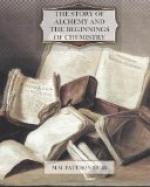Experiment.—Various organic substances are analysed by heating in a distillation-apparatus; the products are, in each case, a solid residue, liquids which distil off, and certain spirits which are disengaged.
The results supported the ancient theory which asserted that earth, water, air, and fire are the four Elements of the world. The solid residue represented earth; the liquid products of the distillation, water; and the spirituous substances, air. Fire was regarded sometimes as the means of purification, sometimes as the soul, or invisible part, of all substances.
Experiment.-A strong acid is poured on to copper. The metal is attacked, and at last disappears, giving place to a green liquid, as transparent as water. A thin sheet of iron is plunged into the liquid; the copper re-appears, and the iron vanishes.
What more simple than to conclude that the iron has been transformed into copper?
Had lead, silver, or gold been used in place of copper, one would have said that the iron was transformed into lead, silver, or gold.
In their search for “the pure and penetrating matter which applied to any substance exalts and perfects it after its own kind,” the alchemists necessarily made many inventions, laid the foundation of many arts and manufactures, and discovered many facts of importance in the science of chemistry.
The practitioners of the Sacred Art of Egypt must have been acquainted with many operations which we now class as belonging to applied chemistry; witness, their jewellery, pottery, dyes and pigments, bleaching, glass-making, working in metals and alloys, and their use of spices, essential oils, and soda in embalming, and for other purposes.
During the centuries when alchemy flourished, gunpowder was invented, the art of printing was established, the compass was brought into use, the art of painting and staining glass was begun and carried to perfection, paper was made from rags, practical metallurgy advanced by leaps and bounds, many new alloys of metals came into use, glass mirrors were manufactured, and considerable advances were made in practical medicine and sanitation.
[Illustration: FIG. XI. See p. 92.]
Basil Valentine, who was one of the greatest alchemists of the 16th century, discovered many of the properties of the metal antimony, and prepared and examined many compounds of that metal; he made green vitriol from pyrites, brandy from fermented grape-juice, fulminating gold, sulphide of potash, and spirits of salt; he made and used baths of artificial mineral waters, and he prepared various metals by what are now called wet methods, for instance, copper, by immersing plates of iron in solutions of bluestone. He examined the air of mines, and suggested practical methods for determining whether the air in a mine was respirable.




